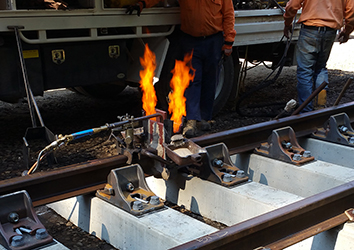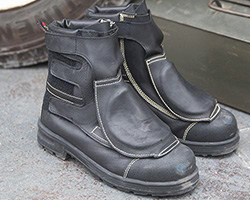ASTM F2413-11 Requirements
ASTM F2413-11 Standard Specification for Performance Requirements for Safety Toe Cap Footwear covers minimum requirements for the design, performance, testing and classification of protective footwear. The purpose of this standard is the certification of protective footwear. The certification must be performed by independent third party laboratories.
Footwear certified as meeting ASTM F2413-11 must first meet the requirements of Section 5.1 Impact Resistant Footwear and Section 5.2 Compression Resistant Footwear. Then the requirements of additional sections such as metatarsal protection, conductive protection, electric hazard resistance, static dissipative protection and protection against punctures can be met.
All footwear manufactured to the ASTM specification must be marked with the specific portion of the standard with which it complies. One shoe of each pair must be clearly and legibly marked (stitched in, stamped on, pressure sensitive label, etc.) on either the surface of the tongue, gusset, shaft or quarter lining. The marking must be enclosed in a rectangular border and a four-line format is suggested. Line four is used only when more than three sections of the standard applies to the footwear.
Each protective toe cap must be marked with the manufacturer’s name, trademark or logo. The cap number or identification, toe cap size and R (right) / L (left) must be permanently stamped or marked in a conspicuous location. Each metatarsal and puncture-resistant device must be marked with the manufacturer’s name, trademark or logo and device number or identification in a conspicuous location.
The following is an example of an ASTM F2413-11 marking that may be found on safety footwear:
ASTM F2413-11
M I/75/C/75/Mt75
PR

Line #1: ASTM F2413-11
This line identifies the ASTM standard. It indicates that the safety footwear meets the performance requirements of ASTM F2413 issued in 2011.
Line #2: M I/75 C/75 Mt75
This line identifies the gender (M [Male] or F [Female]) of the user. It also identifies the existence of impact resistance (I), the impact resistance rating (75 foot-pounds), compression resistance (C) and the compression resistance rating (75) which correlates to 2500 pounds of compression. The metatarsal designation (Mt) and rating (75 foot-pounds) is also identified.
Lines 3 & 4: PR
Lines 3 and 4 are used to identify footwear made to offer protection from other specific types of hazards referenced in the standard. They are used to designate conductive (Cd) properties, electrical hazard resistance properties (EH), footwear designed to reduce the accumulation of excess static electricity (SD) and puncture resistance (PR).
Conductive (Cd) footwear is intended to provide protection for the wearer against hazards that may result from static electricity buildup and to help reduce the possibility of ignition of explosives or volatile chemicals. The footwear must facilitate electrical conductivity and the transfer of static electricity buildup from the body to the ground. The electrical resistance must range between zero and 500,000 ohms.
Electrical hazard (EH) footwear is manufactured with non-conductive, electrical shock-resistant soles and heels. The outsole is intended to provide a secondary source of electric shock-resistance protection to the wearer against the hazards from an incidental contact with live electrical circuits, electrically energized conductors, parts or apparatus. It must be capable of withstanding the application of 18,000 volts at 60 hertz for one minute with no current flow or leakage current in excess of one milliampere under dry conditions.
Static dissipative (SD) footwear is designed to provide protection against hazards that may exist due to excessively low footwear resistance, as well as maintain a sufficiently high level of resistance to reduce the possibility of electric shock. The footwear must have a lower limit of electrical resistance of 106 ohms and an upper limit of 108 ohms.
Puncture-resistant (PR) footwear is designed so that a puncture-resistant plate is positioned between the insole and outsole. It is an integral and permanent part of the footwear. Devices constructed of metal must pass the ASTM B117-11 Standard Practice for Operating Salt Spray (Fog Apparatus) corrosion resistance testing. The device must show no sign of corrosion after being exposed to a five percent salt solution for 24 hours. The puncture-resistant footwear must show no signs of cracking after being subjected to 1.5 million flexes and have a minimum puncture resistance of 270 pounds.
Any changes to the original components of safety toe footwear such as replacing or adding aftermarket footbeds/inserts could cause failure to any or all parts of the ASTM standard and the marking would be invalid.
Add-On Devices
 An important point to remember is that the ASTM standard does not allow for the use of add-on type devices (strap-on foot, toe or metatarsal guards) as a substitute for safety footwear. According to the ASTM standard, any protective toe cap or metatarsal guard must be designed, constructed and manufactured into the safety footwear during the manufacturing process and tested as an integral part of the footwear.
An important point to remember is that the ASTM standard does not allow for the use of add-on type devices (strap-on foot, toe or metatarsal guards) as a substitute for safety footwear. According to the ASTM standard, any protective toe cap or metatarsal guard must be designed, constructed and manufactured into the safety footwear during the manufacturing process and tested as an integral part of the footwear.
While ASTM excludes add-on devices, it doesn’t necessarily mean they’re not acceptable to OSHA. This paradox exists because OSHA states in 1910.136(b)(2) “Safety footwear that the employer demonstrates is at least as effective as safety footwear that is constructed in accordance with one of the above consensus standards will be deemed to be in compliance with the requirements of this section.” This means that if an employer can provide documentation, such as testing data proving their add-on devices provide protection equivalent to any of the incorporated by reference performance standards, then the add-on devices are acceptable to OSHA. Most manufacturers of add-on devices have submitted their products to independent laboratories for testing. This data and its results can be obtained upon request.
Commonly Asked Questions
Q: What is a composite safety toe shoe?
A: As the name suggests, instead of steel, composite toe shoes have a type of composite material in them. These materials are usually a combination of plastic, Kevlar® and carbon fibers. Steel and other alloy materials are stronger than the composite materials. Because the composite materials are not quite as strong as the steel and other alloys, the composite toes have to be thicker and more bulbous. This limits the styles that can effectively use composite toes.
Q: When is footwear with impact and compression protection suggested for use?
A: Per Appendix B to Subpart I, safety shoes or boots with impact protection are suggested for carrying or handling materials such as packages, objects, parts or heavy tools, which could be dropped; and, for other activities where objects might fall onto the feet. Safety shoes or boots with compression protection are suggested for work activities involving skid trucks, around bulk rolls (such as paper rolls) and around heavy pipes, all of which could potentially roll over an employee’s feet.


